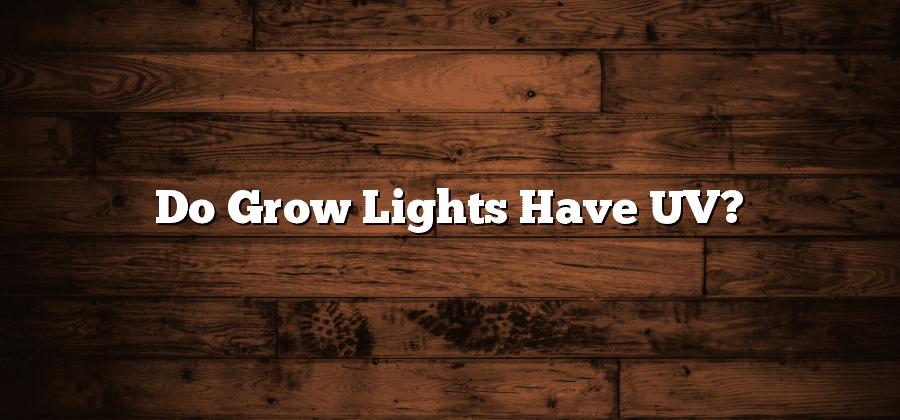Types of Light Spectrums in Grow Lights
The world of indoor gardening has seen significant advancements in recent years, particularly in the realm of grow lights. These artificial light sources play a crucial role in ensuring optimal plant growth and development for indoor plants. Understanding the different types of light spectrums offered by grow lights is essential for selecting the right lighting system for your specific needs.
One of the most common types of light spectrums found in grow lights is the full spectrum. This type of light mimics natural sunlight, providing plants with a wide range of wavelengths necessary for photosynthesis. Full spectrum grow lights typically include a combination of cool and warm white LEDs, as well as red and blue LEDs. This comprehensive light spectrum ensures that plants receive the necessary light energy for all stages of growth, from seedling to flowering.
The Importance of UV in Plant Growth
Plants require various forms of light for their growth and development. While visible light is necessary for photosynthesis, ultraviolet (UV) light also plays a vital role in plant growth. UV light, specifically UV-A and UV-B spectrums, has been shown to affect different aspects of plant physiology.
UV-A light, which falls within the 315 to 400-nanometer range, influences plant development by regulating processes such as seed germination, flowering, and fruit ripening. Exposure to UV-A light promotes the synthesis of important secondary metabolites, such as flavonoids and anthocyanins, which contribute to plant pigmentation and act as natural UV protectants. Additionally, UV-A light can enhance the nutritional value of certain plants by increasing the production of compounds such as antioxidants and essential oils.
On the other hand, UV-B light, ranging from 280 to 315 nanometers, has both positive and negative effects on plant growth. While excessive UV-B exposure can harm plants by damaging cellular components and suppressing photosynthesis, moderate levels of UV-B have been found to stimulate the production of protective compounds. These include flavonoids, phenolic compounds, and antioxidants, which help plants withstand UV stress and protect them against harmful pathogens.
Understanding the importance of UV light in plant growth can lead to effective strategies for optimizing plant development and improving crop yield. Researchers and horticulturists continue to explore the effects of different UV spectrums on plant responses, enabling the development of UV-enhanced grow lights to better mimic natural sunlight and enhance plant growth in controlled environments.
Understanding the UV-A Spectrum in Grow Lights
The UV-A spectrum is a crucial component of grow lights that is often overlooked. While UV-B and UV-C spectrums have received more attention due to their potential harm to plants and humans, UV-A is actually highly beneficial for plant growth and development. UV-A, also known as long-wave ultraviolet light, falls within the wavelength range of 315 to 400 nanometers.
UV-A light plays a significant role in a plant’s life cycle, influencing various physiological processes such as photosynthesis and the production of secondary metabolites. It is known to stimulate plant growth and enhance overall plant health. Additionally, UV-A light can help trigger the production of protective compounds in plants, such as antioxidants and flavonoids, which help defend against environmental stressors such as UV-B and high light intensity. Thus, understanding and utilizing the UV-A spectrum in grow lights can greatly optimize plant growth and improve crop yields.
The Effects of UV-B on Plant Development
UV-B light, or ultraviolet-B radiation, is an important component of the light spectrum that can have both positive and negative effects on plant development. When exposed to moderate levels of UV-B, plants can undergo various physiological and morphological changes. For instance, UV-B exposure can stimulate the production of protective compounds such as flavonoids, which can act as antioxidants and provide protection against UV-induced damage. These compounds not only serve as a defense mechanism against harmful radiation but also play a role in attracting pollinators. Additionally, UV-B light can promote the synthesis of certain hormones, such as auxins and gibberellins, which are involved in plant growth and development.
However, excessive exposure to UV-B radiation can be detrimental to plants. It can lead to cellular damage, including the destruction of DNA and proteins. This can result in reduced photosynthetic activity, growth inhibition, and even plant death. The negative impacts of UV-B radiation on plant development can vary depending on factors such as the species, cultivar, and environmental conditions. It is essential for growers and researchers to understand the balance between the benefits and risks associated with UV-B exposure in order to optimize plant growth and achieve desirable outcomes in cultivation practices.
UV-C Light and Its Impact on Plants
UV-C light is a short-wavelength ultraviolet light that is known for its powerful germicidal properties. Although UV-C light has a detrimental effect on microorganisms, its impact on plant growth and development is not well understood. Research suggests that exposure to UV-C light can have both positive and negative effects on plants, depending on the intensity and duration of exposure.
Several studies have shown that low levels of UV-C light can stimulate the production of secondary metabolites in plants, such as flavonoids and phenolics, which play important roles in defense against environmental stresses. These compounds not only enhance the plant’s resistance to pathogens, but also act as antioxidants, protecting the plant from oxidative damage. On the other hand, excessive exposure to UV-C light can result in negative effects on plant growth, including reduced photosynthetic activity, inhibition of seed germination, and impaired cell division. Therefore, it is crucial to carefully manage the intensity and duration of UV-C light exposure in order to harness its potential benefits for plant growth while minimizing any potential harm.






